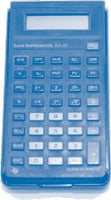Significant Moments in the History of Calculators on CAS Exams
When the Technology Based Examinations (TBE) were announced, I was pretty shocked to hear that the candidates sitting for a TBE exam would not be able to use a calculator for the exam. Of course, there is no need for a calculator when you have Excel at your fingertips, but my calculators were so important to me during my fellowship journey that I think of calculators as a necessary component of actuarial exams. They are the physical embodiment of all the study hours we put in as well as (fairly) reliable friends to have by our sides during the exams. The satisfying click of snapping a calculator back in its case at the conclusion of a study session or exam is a great transition, signaling to yourself that you are done with your tough analysis and have some time for non-computational pursuits. While many of us actuaries and candidates have had this experience with calculators, there are many actuaries who have not. Calculators were not used on CAS exams until 1982. Before they are disallowed for CAS exams completely, let us acknowledge their importance in our society's development by examining their significant moments over time.
1982 – Calculators are allowed for the first time for Parts 5-10. The electronic calculators, which are to be supplied by the candidate, must meet the following standards:
- portable
- battery operated during examination; and,
- must not be programmable

1983 – Calculators are allowed for Part 4.
1984 – Calculators are allowed for Parts 1-3. The requirement that they cannot emit distracting noises is added.
1986 – For Parts 1-3, the only acceptable calculator for use on the examinations is the one sold by the SOA.
1988 – For Parts 4-10, calculators must be silent, and they cannot have any pre-programmed annuity functions.
1989 – A calculator with a power key (yx) is highly recommended.

1992 – The SOA calculator may be used on CAS exams. The requirement that the calculators cannot have any pre-programmed annuity functions is removed.
1995 – For all CAS exams, the only acceptable calculator is the official SOA calculator. Supervisors will have spare calculators on hand, but they will only be available to candidates who brought a calculator with them that happened to malfunction.
1997 – The syllabus has a new section titled "Calculators." Candidates must use the SOA calculator for all jointly administered exams. For CAS exams, candidates may use the BA-35 or TI-30X. Unauthorized calculators will be confiscated. Those who brought in unauthorized calculators are not able to use any of the spare BA-35 calculators that the supervisors will have.
1998 – The TI-30Xa is also allowed on CAS-administered exams. Supervisors will only have one spare BA-35 calculator instead of multiple. The calculators can be solar-powered.
2000 – The SOA calculator is no longer the only calculator that can be used on jointly-administered exams.
2001 – The TI-30X II is added to the list of approved calculators. If using that calculator, the candidate must show the proctor the calculator with the calculator screen showing "MEM CLEARED".
2003 – The BA II Plus is added to the list of approved calculators. Calculator instructions cannot be brought into the exam room. The calculator must be removed from its case when shown to the proctor. Candidates with unauthorized calculators will be subject to exam disqualification or other disciplinary actions.
2006 – The TI-30X is removed from the approved calculator list. The BA II Plus Professional is added.
2009 – The TI-30XS MultiView (or XB battery) is added to the approved calculator list.
2016 – Proctors no longer have a spare calculator.
2018 – Calculators are no longer allowed on Technology Based Exam 5.

